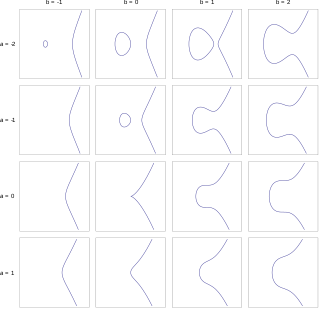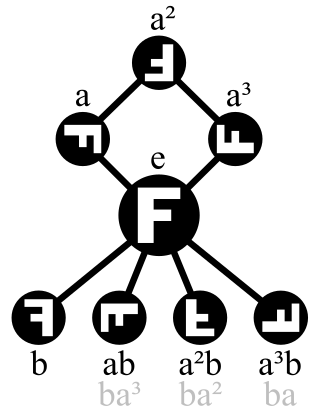
In mathematics, an abelian group, also called a commutative group, is a group in which the result of applying the group operation to two group elements does not depend on the order in which they are written. That is, the group operation is commutative. With addition as an operation, the integers and the real numbers form abelian groups, and the concept of an abelian group may be viewed as a generalization of these examples. Abelian groups are named after early 19th century mathematician Niels Henrik Abel.

In mathematics, an elliptic curve is a smooth, projective, algebraic curve of genus one, on which there is a specified point O. An elliptic curve is defined over a field K and describes points in K2, the Cartesian product of K with itself. If the field's characteristic is different from 2 and 3, then the curve can be described as a plane algebraic curve which consists of solutions (x, y) for:

In mathematics, a field is a set on which addition, subtraction, multiplication, and division are defined and behave as the corresponding operations on rational and real numbers do. A field is thus a fundamental algebraic structure which is widely used in algebra, number theory, and many other areas of mathematics.

In group theory, a branch of abstract algebra in pure mathematics, a cyclic group or monogenous group is a group, denoted Cn, that is generated by a single element. That is, it is a set of invertible elements with a single associative binary operation, and it contains an element g such that every other element of the group may be obtained by repeatedly applying the group operation to g or its inverse. Each element can be written as an integer power of g in multiplicative notation, or as an integer multiple of g in additive notation. This element g is called a generator of the group.

In mathematics, a dyadic rational or binary rational is a number that can be expressed as a fraction whose denominator is a power of two. For example, 1/2, 3/2, and 3/8 are dyadic rationals, but 1/3 is not. These numbers are important in computer science because they are the only ones with finite binary representations. Dyadic rationals also have applications in weights and measures, musical time signatures, and early mathematics education. They can accurately approximate any real number.
In abstract algebra, an abelian group is called finitely generated if there exist finitely many elements in such that every in can be written in the form for some integers . In this case, we say that the set is a generating set of or that generate.
In mathematics, the rank, Prüfer rank, or torsion-free rank of an abelian group A is the cardinality of a maximal linearly independent subset. The rank of A determines the size of the largest free abelian group contained in A. If A is torsion-free then it embeds into a vector space over the rational numbers of dimension rank A. For finitely generated abelian groups, rank is a strong invariant and every such group is determined up to isomorphism by its rank and torsion subgroup. Torsion-free abelian groups of rank 1 have been completely classified. However, the theory of abelian groups of higher rank is more involved.
In mathematics, a free abelian group is an abelian group with a basis. Being an abelian group means that it is a set with an addition operation that is associative, commutative, and invertible. A basis, also called an integral basis, is a subset such that every element of the group can be uniquely expressed as an integer combination of finitely many basis elements. For instance the two-dimensional integer lattice forms a free abelian group, with coordinatewise addition as its operation, and with the two points (1,0) and (0,1) as its basis. Free abelian groups have properties which make them similar to vector spaces, and may equivalently be called free-modules, the free modules over the integers. Lattice theory studies free abelian subgroups of real vector spaces. In algebraic topology, free abelian groups are used to define chain groups, and in algebraic geometry they are used to define divisors.
In abstract algebra, a branch of mathematics, an Archimedean group is a linearly ordered group for which the Archimedean property holds: every two positive group elements are bounded by integer multiples of each other. The set R of real numbers together with the operation of addition and the usual ordering relation between pairs of numbers is an Archimedean group. By a result of Otto Hölder, every Archimedean group is isomorphic to a subgroup of this group. The name "Archimedean" comes from Otto Stolz, who named the Archimedean property after its appearance in the works of Archimedes.
In algebra, a valuation is a function on a field that provides a measure of the size or multiplicity of elements of the field. It generalizes to commutative algebra the notion of size inherent in consideration of the degree of a pole or multiplicity of a zero in complex analysis, the degree of divisibility of a number by a prime number in number theory, and the geometrical concept of contact between two algebraic or analytic varieties in algebraic geometry. A field with a valuation on it is called a valued field.

In algebra, a finitely generated group is a group G that has some finite generating set S so that every element of G can be written as the combination of finitely many elements of S and of inverses of such elements.
In mathematics, a locally compact topological group G has property (T) if the trivial representation is an isolated point in its unitary dual equipped with the Fell topology. Informally, this means that if G acts unitarily on a Hilbert space and has "almost invariant vectors", then it has a nonzero invariant vector. The formal definition, introduced by David Kazhdan (1967), gives this a precise, quantitative meaning.
In mathematics, a character group is the group of representations of a group by complex-valued functions. These functions can be thought of as one-dimensional matrix representations and so are special cases of the group characters that arise in the related context of character theory. Whenever a group is represented by matrices, the function defined by the trace of the matrices is called a character; however, these traces do not in general form a group. Some important properties of these one-dimensional characters apply to characters in general:

In mathematics, the lattice of subgroups of a group is the lattice whose elements are the subgroups of , with the partial order relation being set inclusion. In this lattice, the join of two subgroups is the subgroup generated by their union, and the meet of two subgroups is their intersection.

In mathematics, specifically in group theory, the Prüfer p-group or the p-quasicyclic group or p∞-group, Z(p∞), for a prime number p is the unique p-group in which every element has p different p-th roots.
In mathematics, in the field of group theory, a locally finite group is a type of group that can be studied in ways analogous to a finite group. Sylow subgroups, Carter subgroups, and abelian subgroups of locally finite groups have been studied. The concept is credited to work in the 1930s by Russian mathematician Sergei Chernikov.
In abstract algebra, every subgroup of a cyclic group is cyclic. Moreover, for a finite cyclic group of order n, every subgroup's order is a divisor of n, and there is exactly one subgroup for each divisor. This result has been called the fundamental theorem of cyclic groups.
In the branch of mathematics known as universal algebra, a subdirectly irreducible algebra is an algebra that cannot be factored as a subdirect product of "simpler" algebras. Subdirectly irreducible algebras play a somewhat analogous role in algebra to primes in number theory.
In the mathematical subject of geometric group theory, the Baumslag–Gersten group, also known as the Baumslag group, is a particular one-relator group exhibiting some remarkable properties regarding its finite quotient groups, its Dehn function and the complexity of its word problem.
In the mathematical subject of group theory, a co-Hopfian group is a group that is not isomorphic to any of its proper subgroups. The notion is dual to that of a Hopfian group, named after Heinz Hopf.







